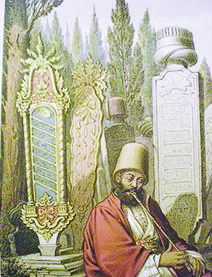The city of the dead: Eyüp
Niki Gamm ISTANBUL - Hürriyet Daily News
 “At the far end of the bay, on the ground that rises steeply in a sharp slope, stands a sanctuary dedicated from ancient times to the Saints Cosmas and Damian. When the Emperor [Justinian] himself once lay seriously ill, giving the appearance of being actually dead (in fact, he had been given up by physicians as being already numbered among the dead), these saints came to him here in a vision, saved him unexpectedly and, contrary to all human reason, raised him up. In gratitude he gave them such requital as a mortal may, by changing entirely and remodeling the earlier building, which was unsightly, ignoble and not worthy of being dedicated to such powerful saints, and he beautified and enlarged the church, flooding it with brilliant light and adding many other things that it had not before.” [De Aedificis trans. Loeb Classical Library]
“At the far end of the bay, on the ground that rises steeply in a sharp slope, stands a sanctuary dedicated from ancient times to the Saints Cosmas and Damian. When the Emperor [Justinian] himself once lay seriously ill, giving the appearance of being actually dead (in fact, he had been given up by physicians as being already numbered among the dead), these saints came to him here in a vision, saved him unexpectedly and, contrary to all human reason, raised him up. In gratitude he gave them such requital as a mortal may, by changing entirely and remodeling the earlier building, which was unsightly, ignoble and not worthy of being dedicated to such powerful saints, and he beautified and enlarged the church, flooding it with brilliant light and adding many other things that it had not before.” [De Aedificis trans. Loeb Classical Library]The above passage was written in the sixth century by the Byzantine historian Procopius, about a monastery located on the hillside at the end of the Golden Horn that today is associated with the writer Pierre Loti. According to the late French historian Robert Mantran, this monastery and palace was the place where the Byzantine emperor and his nobles and military commanders would be girded with swords before departing for war. There was as well another monastery down the hill, closer to the city walls and just beyond where Eyüp Sultan Mosque is located today. It was the Leon Makelos Monastery but Mantran ignores this.
The early maps of Constantinople don’t show anything beyond the walls of the city. Later cartographers like Matrakci Nasuh show virtually nothing and this has led historians to believe that the area was used only for grazing cattle and growing vegetables and flowers, without any prominent buildings there.
Eyüp appears to have been the first “city” to be built outside the walls of Constantinople. There is a well-known legend that the Prophet Mohammed’s standard bearer died during an attempt by an Arab army to take the city in the seventh century and was buried near the walls. Two stories arose. One is that to hide where Eyüp al-Ansari was buried, Arab cavalry trampled over the grave area. The other story relates how the Byzantines venerated Ayup and visited his grave because they believed he was capable of healing illnesses. But when Fatih Sultan Mehmet conquered the city in 1453, he wanted to find the grave and no one knew where it was until his grand vizier dreamed about it one night. The next morning, he led Mehmet there and they uncovered the grave, entombed with a marble slab on which was written in kufic letters, “Eba Eyüp.” The sultan then had the body reinterred and a shrine built, which was later replaced with a mosque and mosque complex on the site.
Fatih’s mosque eventually fell into disrepair and was restored by Damad Nevsehirli Ibrahim Pasa in the first half of the 18th century. Minarets with two balconies for the call to prayer were replaced at the same time in the name of Sultan Ahmed III. However, following one of Istanbul’s major earthquakes in 1766, the mosque was rebuilt entirely and is still in existence today.
 One of three holy places
One of three holy places The Eyüp Sultan Mosque became known as one of three holy places of pilgrimage, following Mecca and Jerusalem. For example, the Ozbek Turks, when performing the hajj to Mecca, would come through Istanbul in order to pray at the shrine instead of going through Bagdad.
The area around the mosque was not very heavily populated although many of the residents were Armenian and Bulgarian. There was and still is a small Armenian church, Surp Asdvadzadzin (Holy Mother of God). Historian P. F. Incicyan in his book on Istanbul in the 18th century refers to an Armenian church, Surp Eğia (St. Elijah), that was closed on May 10, 1766, coincidentally just 12 days before the earthquake that destroyed the Eyüp Sultan Mosque. Surp Eğia was again rebuilt with imperial permission in 1800.
The Armenians and Bulgarians worked primarily as gardeners in the Eyüp area, which was covered in orchards and gardens. Sarraf-Hovannesyan, an 18th century writer, wrote about the garden – or rather the farm – of Rami Mehmed Paşa that was located behind Eyüp. The paşa held the post of grand vizier in 1703 when the people rose in revolt against Sultan Mustafa II (Incicyan mistakenly writes that this was Mustafa III) and marched on Edirne. The sultan subsequently fled to Istanbul, where he hid on Rami Mehmed’s farm until the danger had subsided. However, both he and Rami Mehmed were deposed.
In addition to gardens, the sanctity of Eyüp Sultan Mosque led high-ranking government officials and members of the imperial dynasty to erect their mausoleums there. Not only are there mausoleums but also other mosques, mosque complexes, medreses (schools) and lodges belonging to dervish sects erected in the area. A number of these still exist. What do not exist today are the palaces, which were erected for the sisters and daughters of the sultans. At the time, of course, the Golden Horn was a popular place to go boating and hold festivities of various sorts such as the picnics that the 17th century travel writer Evliya Celebi mentions in his Seyahatname. The sultans were known to sail up the Golden Horn and visit their relatives for a change of atmosphere from Topkapı Palace.
These waterside palaces must have been magnificent, as one can see from just the surviving engravings of the interior of the home of Fatma Sultan. One is reminded, however, that possession of these buildings was often quite short. They belonged to the sultan and whenever the sultan changed, the palaces changed hands. Fatma Sultan inherited her palace from her mother, who was the valide sultan (mother of the sultan), and she in turn had to give it up after her brother, Sultan Ahmed III, was deposed and her husband, Damad Nevşehirli Ibrahim Paşa, was executed.
A quiet suburb
Those days are long gone. By the 19th century, the imperial family had become enamored of the Bosphorus. Eyüp settled back into being a quiet suburb of Istanbul. The description that the 19th century Italian traveler gives is still appropriate today.
“This is like an aristocratic district buried in extraordinary silence, a city of graves that has a white, shady and extraordinary beauty that inspires the feeling of worldly reverence and otherworldly melancholy… Nowhere else in Istanbul is there spread out the art of the Muslim that enhances the portrayal of death and looks on it without fear. This is a cemetery, a palace, a garden, a place of worship that awakens a prayer and a smile on the lips.”
















